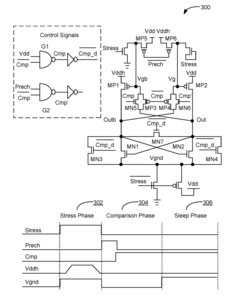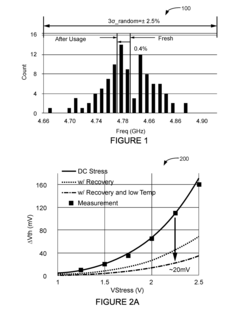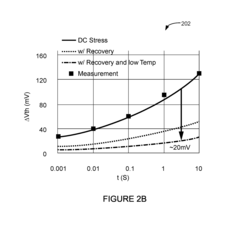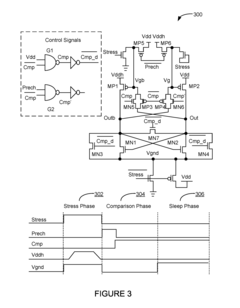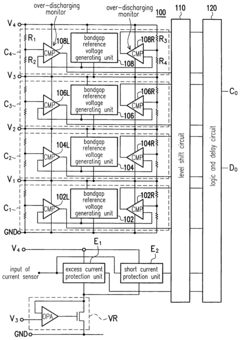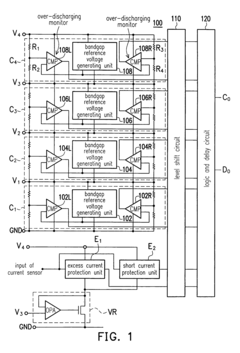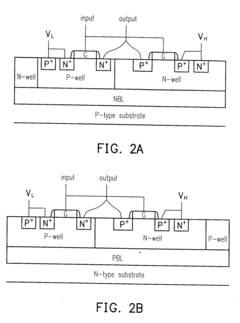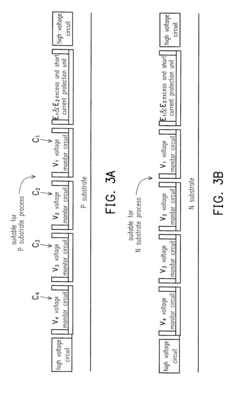How CMOS Battery Drives Interactive Enterprise Ecosystem Growth?
JUL 22, 20259 MIN READ
Generate Your Research Report Instantly with AI Agent
Patsnap Eureka helps you evaluate technical feasibility & market potential.
CMOS Battery Evolution
The evolution of CMOS battery technology has played a crucial role in shaping the interactive enterprise ecosystem. Initially developed in the 1980s, CMOS (Complementary Metal-Oxide-Semiconductor) batteries were primarily used to maintain basic system settings and real-time clock functions in personal computers. However, their impact has grown significantly over the years, becoming an integral part of enterprise hardware infrastructure.
In the early stages, CMOS batteries were simple lithium coin cells with limited capacity and lifespan. As enterprise systems became more complex, the demands on these batteries increased. This led to the development of more advanced CMOS battery technologies, including rechargeable versions and those with extended lifespans. These improvements were critical in ensuring the reliability and continuity of enterprise operations.
The late 1990s and early 2000s saw a shift towards more energy-efficient CMOS designs, which reduced the power consumption of enterprise hardware. This evolution allowed for smaller CMOS batteries with longer operational lives, contributing to the miniaturization of enterprise devices and the rise of mobile computing in business environments. The reduced power requirements also paved the way for the integration of CMOS functionality into other components, further enhancing system efficiency.
As cloud computing and distributed systems gained prominence in the enterprise ecosystem, CMOS batteries adapted to support these new paradigms. They began to play a crucial role in maintaining system integrity during power outages and facilitating seamless transitions between power sources. This evolution was particularly important for data centers and mission-critical systems, where even momentary disruptions could have significant consequences.
The Internet of Things (IoT) revolution in the 2010s brought about another significant shift in CMOS battery technology. Enterprise ecosystems expanded to include a vast array of connected devices, each requiring reliable power management. CMOS batteries evolved to meet these needs, incorporating features such as ultra-low power consumption and the ability to harvest energy from the environment.
Recent advancements have focused on enhancing the sustainability and environmental friendliness of CMOS batteries. This includes the development of non-toxic materials and improved recycling processes, aligning with the growing emphasis on corporate social responsibility and green technology initiatives within the enterprise sector.
Looking ahead, the evolution of CMOS batteries continues to drive innovation in enterprise ecosystems. Emerging technologies such as AI-powered predictive maintenance and self-healing systems are being integrated with CMOS battery management, further enhancing the reliability and efficiency of enterprise hardware. As the boundaries between physical and digital infrastructures blur, CMOS batteries are poised to play an even more critical role in powering the next generation of interactive enterprise ecosystems.
In the early stages, CMOS batteries were simple lithium coin cells with limited capacity and lifespan. As enterprise systems became more complex, the demands on these batteries increased. This led to the development of more advanced CMOS battery technologies, including rechargeable versions and those with extended lifespans. These improvements were critical in ensuring the reliability and continuity of enterprise operations.
The late 1990s and early 2000s saw a shift towards more energy-efficient CMOS designs, which reduced the power consumption of enterprise hardware. This evolution allowed for smaller CMOS batteries with longer operational lives, contributing to the miniaturization of enterprise devices and the rise of mobile computing in business environments. The reduced power requirements also paved the way for the integration of CMOS functionality into other components, further enhancing system efficiency.
As cloud computing and distributed systems gained prominence in the enterprise ecosystem, CMOS batteries adapted to support these new paradigms. They began to play a crucial role in maintaining system integrity during power outages and facilitating seamless transitions between power sources. This evolution was particularly important for data centers and mission-critical systems, where even momentary disruptions could have significant consequences.
The Internet of Things (IoT) revolution in the 2010s brought about another significant shift in CMOS battery technology. Enterprise ecosystems expanded to include a vast array of connected devices, each requiring reliable power management. CMOS batteries evolved to meet these needs, incorporating features such as ultra-low power consumption and the ability to harvest energy from the environment.
Recent advancements have focused on enhancing the sustainability and environmental friendliness of CMOS batteries. This includes the development of non-toxic materials and improved recycling processes, aligning with the growing emphasis on corporate social responsibility and green technology initiatives within the enterprise sector.
Looking ahead, the evolution of CMOS batteries continues to drive innovation in enterprise ecosystems. Emerging technologies such as AI-powered predictive maintenance and self-healing systems are being integrated with CMOS battery management, further enhancing the reliability and efficiency of enterprise hardware. As the boundaries between physical and digital infrastructures blur, CMOS batteries are poised to play an even more critical role in powering the next generation of interactive enterprise ecosystems.
Enterprise Ecosystem Demand
The demand for interactive enterprise ecosystems driven by CMOS battery technology has been steadily growing in recent years. This trend is fueled by the increasing need for seamless connectivity, real-time data exchange, and enhanced collaboration within organizations. As businesses strive to become more agile and responsive to market changes, the integration of CMOS battery-powered devices into enterprise ecosystems has become a critical factor in achieving these goals.
One of the primary drivers of this demand is the growing adoption of Internet of Things (IoT) devices in enterprise environments. CMOS batteries play a crucial role in powering these devices, enabling them to operate for extended periods without frequent recharging or replacement. This longevity is particularly valuable in large-scale deployments where maintenance costs can be significant. The ability to sustain a network of interconnected devices for extended periods has opened up new possibilities for data collection, analysis, and decision-making in various industries.
The healthcare sector has emerged as a significant market for CMOS battery-driven enterprise ecosystems. Hospitals and clinics are increasingly relying on connected medical devices and sensors to monitor patients, track inventory, and optimize resource allocation. The long-lasting power provided by CMOS batteries ensures that these critical systems remain operational around the clock, contributing to improved patient care and operational efficiency.
In the manufacturing industry, the demand for CMOS battery-powered solutions has been driven by the need for real-time monitoring and control of production processes. Smart factories are leveraging networks of sensors and actuators to optimize production lines, predict maintenance needs, and reduce downtime. The reliability and longevity of CMOS batteries make them ideal for powering these mission-critical devices in harsh industrial environments.
The retail sector has also shown a growing interest in CMOS battery-driven enterprise ecosystems. Retailers are adopting smart shelving systems, electronic price tags, and inventory tracking devices to enhance the shopping experience and streamline operations. The low power consumption of CMOS batteries allows these devices to operate for extended periods, reducing maintenance costs and minimizing disruptions to store operations.
As organizations continue to embrace digital transformation, the demand for CMOS battery-powered solutions in enterprise ecosystems is expected to grow further. The ability to create interconnected, always-on environments that seamlessly blend physical and digital elements is becoming a key competitive advantage. This trend is likely to drive innovation in CMOS battery technology, with a focus on increasing energy density, improving charging efficiency, and enhancing overall performance to meet the evolving needs of enterprise ecosystems.
One of the primary drivers of this demand is the growing adoption of Internet of Things (IoT) devices in enterprise environments. CMOS batteries play a crucial role in powering these devices, enabling them to operate for extended periods without frequent recharging or replacement. This longevity is particularly valuable in large-scale deployments where maintenance costs can be significant. The ability to sustain a network of interconnected devices for extended periods has opened up new possibilities for data collection, analysis, and decision-making in various industries.
The healthcare sector has emerged as a significant market for CMOS battery-driven enterprise ecosystems. Hospitals and clinics are increasingly relying on connected medical devices and sensors to monitor patients, track inventory, and optimize resource allocation. The long-lasting power provided by CMOS batteries ensures that these critical systems remain operational around the clock, contributing to improved patient care and operational efficiency.
In the manufacturing industry, the demand for CMOS battery-powered solutions has been driven by the need for real-time monitoring and control of production processes. Smart factories are leveraging networks of sensors and actuators to optimize production lines, predict maintenance needs, and reduce downtime. The reliability and longevity of CMOS batteries make them ideal for powering these mission-critical devices in harsh industrial environments.
The retail sector has also shown a growing interest in CMOS battery-driven enterprise ecosystems. Retailers are adopting smart shelving systems, electronic price tags, and inventory tracking devices to enhance the shopping experience and streamline operations. The low power consumption of CMOS batteries allows these devices to operate for extended periods, reducing maintenance costs and minimizing disruptions to store operations.
As organizations continue to embrace digital transformation, the demand for CMOS battery-powered solutions in enterprise ecosystems is expected to grow further. The ability to create interconnected, always-on environments that seamlessly blend physical and digital elements is becoming a key competitive advantage. This trend is likely to drive innovation in CMOS battery technology, with a focus on increasing energy density, improving charging efficiency, and enhancing overall performance to meet the evolving needs of enterprise ecosystems.
CMOS Power Challenges
CMOS (Complementary Metal-Oxide-Semiconductor) technology has been a cornerstone in the development of modern electronic devices, particularly in enterprise computing systems. However, as the demand for more powerful and energy-efficient devices continues to grow, CMOS technology faces significant power challenges that need to be addressed to drive interactive enterprise ecosystem growth.
One of the primary challenges is the increasing power density in CMOS circuits. As transistor sizes continue to shrink and more components are packed into smaller areas, the power consumption per unit area has risen dramatically. This leads to increased heat generation, which can negatively impact device performance and reliability. Managing this thermal load requires sophisticated cooling solutions, adding complexity and cost to enterprise systems.
Another critical issue is the growing static power consumption due to leakage currents. As transistor dimensions decrease, the gate oxide thickness also reduces, leading to increased gate leakage. Additionally, sub-threshold leakage becomes more pronounced in smaller transistors. These leakage currents contribute significantly to the overall power consumption, even when the device is in standby mode, posing challenges for energy efficiency in enterprise environments.
The dynamic power consumption in CMOS circuits also presents challenges, particularly in high-performance enterprise systems. As clock frequencies increase to meet performance demands, the power required for switching transistors rises proportionally. This creates a trade-off between performance and power efficiency, forcing designers to carefully balance these competing factors in enterprise-grade hardware.
Voltage scaling, a technique traditionally used to reduce power consumption, is becoming less effective as we approach the physical limits of CMOS technology. The threshold voltage of transistors cannot be reduced indefinitely without compromising their switching reliability. This limitation constrains the ability to lower operating voltages, making it increasingly difficult to achieve significant power savings through this method.
The increasing complexity of enterprise systems, with multiple cores, specialized accelerators, and heterogeneous computing elements, further exacerbates power management challenges. Coordinating power states across these diverse components while maintaining system responsiveness and meeting performance requirements is a complex task that requires sophisticated power management algorithms and hardware support.
Lastly, the need for always-on functionality in many enterprise applications conflicts with power-saving strategies. Features such as instant-on capabilities, background processing, and constant network connectivity demand that certain system components remain active even in low-power states. Balancing these always-on requirements with overall system power efficiency is a significant challenge in the enterprise ecosystem.
One of the primary challenges is the increasing power density in CMOS circuits. As transistor sizes continue to shrink and more components are packed into smaller areas, the power consumption per unit area has risen dramatically. This leads to increased heat generation, which can negatively impact device performance and reliability. Managing this thermal load requires sophisticated cooling solutions, adding complexity and cost to enterprise systems.
Another critical issue is the growing static power consumption due to leakage currents. As transistor dimensions decrease, the gate oxide thickness also reduces, leading to increased gate leakage. Additionally, sub-threshold leakage becomes more pronounced in smaller transistors. These leakage currents contribute significantly to the overall power consumption, even when the device is in standby mode, posing challenges for energy efficiency in enterprise environments.
The dynamic power consumption in CMOS circuits also presents challenges, particularly in high-performance enterprise systems. As clock frequencies increase to meet performance demands, the power required for switching transistors rises proportionally. This creates a trade-off between performance and power efficiency, forcing designers to carefully balance these competing factors in enterprise-grade hardware.
Voltage scaling, a technique traditionally used to reduce power consumption, is becoming less effective as we approach the physical limits of CMOS technology. The threshold voltage of transistors cannot be reduced indefinitely without compromising their switching reliability. This limitation constrains the ability to lower operating voltages, making it increasingly difficult to achieve significant power savings through this method.
The increasing complexity of enterprise systems, with multiple cores, specialized accelerators, and heterogeneous computing elements, further exacerbates power management challenges. Coordinating power states across these diverse components while maintaining system responsiveness and meeting performance requirements is a complex task that requires sophisticated power management algorithms and hardware support.
Lastly, the need for always-on functionality in many enterprise applications conflicts with power-saving strategies. Features such as instant-on capabilities, background processing, and constant network connectivity demand that certain system components remain active even in low-power states. Balancing these always-on requirements with overall system power efficiency is a significant challenge in the enterprise ecosystem.
Current CMOS Solutions
01 Enterprise ecosystem management and growth
Systems and methods for managing and growing enterprise ecosystems, focusing on interactive platforms that facilitate collaboration, resource sharing, and business process optimization across multiple organizations. These solutions enable companies to adapt to changing market conditions, foster innovation, and create value through strategic partnerships.- Enterprise ecosystem management and growth: Systems and methods for managing and growing enterprise ecosystems, focusing on interactive platforms that facilitate collaboration, resource sharing, and business process optimization across multiple organizations. These solutions enable companies to adapt to changing market conditions, foster innovation, and create value through interconnected business networks.
- CMOS battery management in enterprise systems: Techniques for efficient management of CMOS batteries in enterprise computing environments, including monitoring, maintenance, and replacement strategies. These approaches aim to ensure system reliability, prevent data loss, and minimize downtime in large-scale IT infrastructures.
- Interactive user interfaces for enterprise systems: Development of advanced user interfaces that enhance interaction within enterprise ecosystems. These interfaces incorporate features such as touch-sensitive displays, gesture recognition, and adaptive layouts to improve user experience and productivity in complex business environments.
- Data analytics and AI in enterprise growth: Integration of data analytics and artificial intelligence technologies to drive enterprise ecosystem growth. These solutions leverage big data, machine learning, and predictive modeling to provide insights, automate decision-making processes, and identify new business opportunities within interconnected corporate networks.
- Secure communication in enterprise ecosystems: Implementation of secure communication protocols and technologies to protect sensitive information within enterprise ecosystems. These systems ensure data integrity, confidentiality, and compliance with regulatory requirements while facilitating seamless collaboration among ecosystem participants.
02 CMOS battery management in enterprise systems
Techniques for efficient management of CMOS batteries in enterprise computing environments, including monitoring, maintenance, and replacement strategies. These approaches aim to ensure system stability, prevent data loss, and minimize downtime in large-scale IT infrastructures.Expand Specific Solutions03 Interactive enterprise software solutions
Development of interactive enterprise software platforms that enhance user engagement, streamline workflows, and improve decision-making processes. These solutions incorporate advanced user interfaces, real-time data analytics, and collaborative tools to boost productivity and drive business growth.Expand Specific Solutions04 Enterprise data management and analytics
Advanced data management and analytics solutions for enterprise ecosystems, enabling organizations to extract valuable insights, optimize operations, and drive growth. These systems leverage big data technologies, machine learning, and predictive analytics to support data-driven decision-making.Expand Specific Solutions05 Scalable enterprise infrastructure solutions
Innovative approaches to designing and implementing scalable enterprise infrastructure solutions that support ecosystem growth. These technologies focus on improving system performance, reliability, and flexibility while accommodating increasing demands and evolving business requirements.Expand Specific Solutions
Key Industry Players
The CMOS battery-driven interactive enterprise ecosystem is in its early growth stage, with increasing market size and evolving technological maturity. Key players like Apple, IBM, and Samsung SDI are driving innovation in this space. The market is characterized by a mix of established tech giants and specialized energy storage companies, indicating a competitive landscape with diverse expertise. As the technology matures, we're seeing advancements in battery management systems, energy efficiency, and integration with enterprise software platforms. This convergence of hardware and software solutions is creating new opportunities for ecosystem growth and enterprise adoption.
Apple, Inc.
Technical Solution: Apple's approach to CMOS battery technology in driving interactive enterprise ecosystem growth focuses on seamless integration across their device ecosystem. They utilize low-power CMOS batteries in devices like the iPhone, iPad, and MacBooks to maintain system time and settings when the main battery is depleted. This allows for quick startup and consistent user experience across their product line. Apple has also developed custom power management integrated circuits (PMICs) that work in conjunction with CMOS batteries to optimize power consumption and extend battery life[1][3]. Their ecosystem approach ensures that CMOS battery-powered features, such as instant-on capabilities and background app refresh, work harmoniously across devices, enhancing overall user productivity in enterprise settings.
Strengths: Seamless integration across devices, custom PMIC technology, and optimized power management. Weaknesses: Closed ecosystem may limit interoperability with non-Apple enterprise solutions.
International Business Machines Corp.
Technical Solution: IBM's strategy for leveraging CMOS battery technology in enterprise ecosystems centers on their mainframe and server technologies. They have developed advanced CMOS-based components for their z15 mainframe systems, which utilize CMOS batteries to maintain critical system information and settings. IBM's approach includes implementing energy-efficient CMOS designs that reduce power consumption while maintaining high performance[2]. They have also integrated CMOS battery technology into their cognitive computing platforms, enabling always-on capabilities for AI and machine learning applications in enterprise environments. IBM's Power Systems servers use CMOS batteries to support rapid recovery and system resilience, crucial for maintaining high availability in enterprise data centers[4].
Strengths: High-performance mainframe systems, advanced CMOS designs for energy efficiency, and integration with cognitive computing platforms. Weaknesses: Primarily focused on large-scale enterprise solutions, which may not be suitable for smaller businesses.
Innovative Power Designs
System and method for integrated circuit usage tracking circuit with fast tracking time for hardware security and re-configurability
PatentActiveUS20160329897A1
Innovation
- A silicon marker technique using conventional CMOS devices with an accelerated aging circuit and stochastic processing methodology to create a reliable usage marker within seconds, leveraging NBTI effects and latch-based comparator circuits to enhance detection accuracy and tolerance to process variations.
Complementary metal oxide semiconductor structure for battery protection circuit and battery protection circuit having the same
PatentInactiveUS20050052802A1
Innovation
- The implementation of a CMOS structure using tri-well or buried layer techniques allows for a battery protection circuit that operates at relatively low voltage, isolates substrate noise, and includes overcharging and over-discharging units, excess current protection, and short circuit protection, utilizing NMOS and PMOS transistors with specific voltage configurations and a bandgap reference voltage-generating unit to monitor and regulate battery voltage and current.
Sustainability Factors
The sustainability of CMOS battery-driven interactive enterprise ecosystems hinges on several key factors. Environmental considerations play a crucial role, as the production and disposal of batteries can have significant ecological impacts. Companies must prioritize the use of eco-friendly materials and implement efficient recycling programs to minimize environmental footprints. This approach not only aligns with global sustainability goals but also enhances brand reputation and consumer trust.
Economic sustainability is equally important in this ecosystem. The cost-effectiveness of CMOS batteries, their longevity, and their ability to support long-term enterprise operations are critical factors. As technology advances, the integration of more energy-efficient CMOS batteries can lead to reduced operational costs for businesses, contributing to the overall economic viability of the ecosystem.
Technological adaptability is another vital sustainability factor. The rapid pace of technological change requires CMOS battery systems to be flexible and upgradable. Enterprises must invest in research and development to ensure that their battery-driven systems can evolve with emerging technologies, maintaining relevance and efficiency in the long term.
Social sustainability aspects also come into play. The adoption of CMOS battery-driven systems in enterprise ecosystems can lead to changes in workforce dynamics and skill requirements. Companies need to focus on employee training and development to ensure a smooth transition and maintain a skilled workforce capable of managing these advanced systems.
Regulatory compliance and standardization are crucial for the long-term sustainability of this ecosystem. As governments worldwide implement stricter environmental and data protection regulations, enterprises must ensure that their CMOS battery-driven systems adhere to these standards. This compliance not only avoids legal issues but also promotes trust and interoperability within the ecosystem.
Lastly, the resilience of the supply chain is a key sustainability factor. The interactive enterprise ecosystem relies heavily on a stable supply of CMOS batteries and related components. Diversifying supply sources, developing strategic partnerships with suppliers, and investing in local production capabilities can enhance the ecosystem's resilience against global supply chain disruptions.
Economic sustainability is equally important in this ecosystem. The cost-effectiveness of CMOS batteries, their longevity, and their ability to support long-term enterprise operations are critical factors. As technology advances, the integration of more energy-efficient CMOS batteries can lead to reduced operational costs for businesses, contributing to the overall economic viability of the ecosystem.
Technological adaptability is another vital sustainability factor. The rapid pace of technological change requires CMOS battery systems to be flexible and upgradable. Enterprises must invest in research and development to ensure that their battery-driven systems can evolve with emerging technologies, maintaining relevance and efficiency in the long term.
Social sustainability aspects also come into play. The adoption of CMOS battery-driven systems in enterprise ecosystems can lead to changes in workforce dynamics and skill requirements. Companies need to focus on employee training and development to ensure a smooth transition and maintain a skilled workforce capable of managing these advanced systems.
Regulatory compliance and standardization are crucial for the long-term sustainability of this ecosystem. As governments worldwide implement stricter environmental and data protection regulations, enterprises must ensure that their CMOS battery-driven systems adhere to these standards. This compliance not only avoids legal issues but also promotes trust and interoperability within the ecosystem.
Lastly, the resilience of the supply chain is a key sustainability factor. The interactive enterprise ecosystem relies heavily on a stable supply of CMOS batteries and related components. Diversifying supply sources, developing strategic partnerships with suppliers, and investing in local production capabilities can enhance the ecosystem's resilience against global supply chain disruptions.
Security Implications
The integration of CMOS battery-driven technologies in enterprise ecosystems introduces significant security implications that must be carefully considered. As these systems become more interconnected and reliant on continuous power supply, the potential attack surface expands, necessitating robust security measures.
One primary concern is the vulnerability of CMOS batteries to physical tampering. Unauthorized access to these components could lead to data loss, system configuration changes, or even the introduction of malicious firmware. Enterprises must implement stringent physical security protocols to protect these critical hardware elements from both internal and external threats.
Data integrity is another crucial aspect affected by CMOS battery security. These batteries maintain system time and BIOS settings, which are fundamental to many security protocols, including certificate validation and secure boot processes. A compromised CMOS battery could potentially allow attackers to manipulate system time, bypassing certain security checks or creating opportunities for replay attacks.
The interconnected nature of enterprise ecosystems amplifies the potential impact of CMOS battery-related security breaches. A single compromised device could serve as an entry point for lateral movement across the network, potentially affecting numerous systems and services. This underscores the need for comprehensive security strategies that encompass not only individual devices but also the broader ecosystem.
Power management and battery health monitoring become critical security considerations in this context. Unexpected power loss or battery failure could lead to system vulnerabilities or data corruption. Implementing robust monitoring and alerting systems for CMOS battery health is essential to maintain the overall security posture of the enterprise ecosystem.
As enterprises increasingly adopt cloud-based and distributed architectures, the security implications of CMOS batteries extend beyond individual devices. Synchronization issues or discrepancies in system time across distributed systems could lead to authentication failures, data inconsistencies, or disruptions in critical business processes. Ensuring precise time synchronization and secure communication between distributed components becomes paramount.
The long-term reliability and lifecycle management of CMOS batteries also present security challenges. As these components age, they may become more susceptible to failure or manipulation. Enterprises must develop and implement comprehensive lifecycle management strategies, including regular assessments, replacements, and secure disposal procedures to mitigate potential security risks associated with aging hardware.
In conclusion, while CMOS batteries play a crucial role in driving interactive enterprise ecosystem growth, their security implications are far-reaching and complex. Organizations must adopt a holistic approach to security, encompassing hardware protection, data integrity, network security, and lifecycle management to effectively mitigate risks and ensure the resilience of their ecosystems.
One primary concern is the vulnerability of CMOS batteries to physical tampering. Unauthorized access to these components could lead to data loss, system configuration changes, or even the introduction of malicious firmware. Enterprises must implement stringent physical security protocols to protect these critical hardware elements from both internal and external threats.
Data integrity is another crucial aspect affected by CMOS battery security. These batteries maintain system time and BIOS settings, which are fundamental to many security protocols, including certificate validation and secure boot processes. A compromised CMOS battery could potentially allow attackers to manipulate system time, bypassing certain security checks or creating opportunities for replay attacks.
The interconnected nature of enterprise ecosystems amplifies the potential impact of CMOS battery-related security breaches. A single compromised device could serve as an entry point for lateral movement across the network, potentially affecting numerous systems and services. This underscores the need for comprehensive security strategies that encompass not only individual devices but also the broader ecosystem.
Power management and battery health monitoring become critical security considerations in this context. Unexpected power loss or battery failure could lead to system vulnerabilities or data corruption. Implementing robust monitoring and alerting systems for CMOS battery health is essential to maintain the overall security posture of the enterprise ecosystem.
As enterprises increasingly adopt cloud-based and distributed architectures, the security implications of CMOS batteries extend beyond individual devices. Synchronization issues or discrepancies in system time across distributed systems could lead to authentication failures, data inconsistencies, or disruptions in critical business processes. Ensuring precise time synchronization and secure communication between distributed components becomes paramount.
The long-term reliability and lifecycle management of CMOS batteries also present security challenges. As these components age, they may become more susceptible to failure or manipulation. Enterprises must develop and implement comprehensive lifecycle management strategies, including regular assessments, replacements, and secure disposal procedures to mitigate potential security risks associated with aging hardware.
In conclusion, while CMOS batteries play a crucial role in driving interactive enterprise ecosystem growth, their security implications are far-reaching and complex. Organizations must adopt a holistic approach to security, encompassing hardware protection, data integrity, network security, and lifecycle management to effectively mitigate risks and ensure the resilience of their ecosystems.
Unlock deeper insights with Patsnap Eureka Quick Research — get a full tech report to explore trends and direct your research. Try now!
Generate Your Research Report Instantly with AI Agent
Supercharge your innovation with Patsnap Eureka AI Agent Platform!
